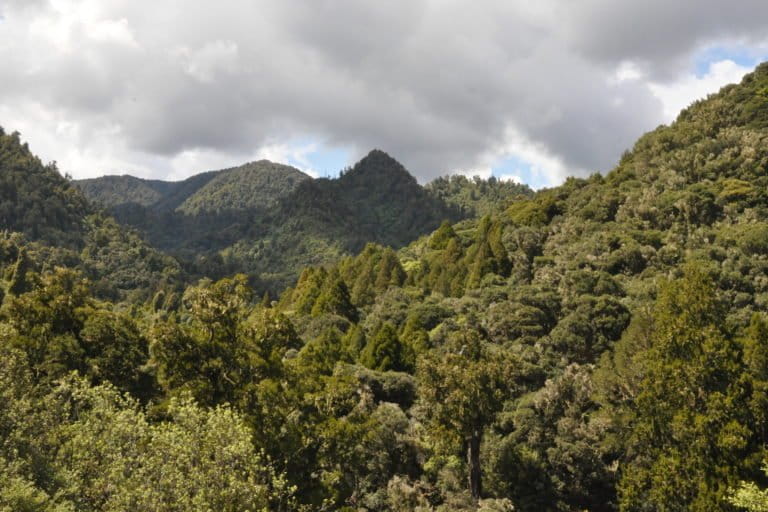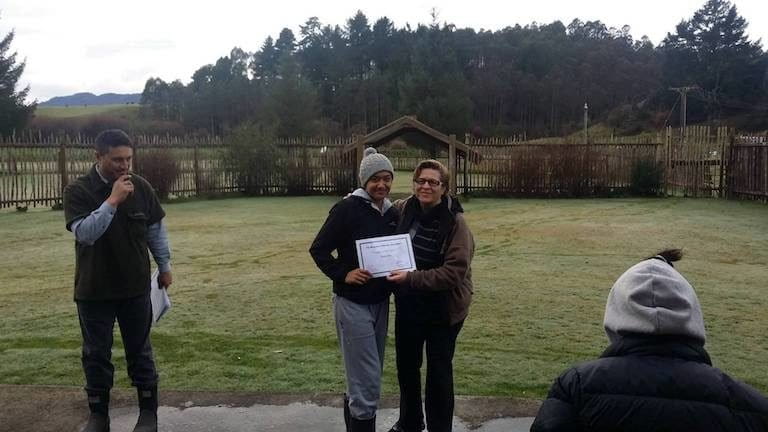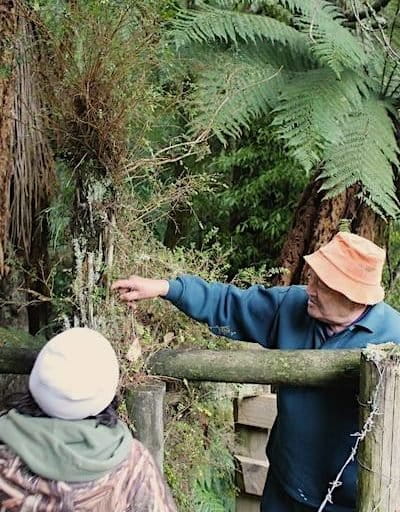- Māori have urbanized rapidly over the last century, undergoing a general disconnection from the environment.
- To buck that trend, members of the Tūhoe tribe in the community of Ruatāhuna, New Zealand, have been teaching their young people about their traditional culture and forest knowledge.
- They’re changing the format of their local schools to reflect a Tūhoe worldview, and have set up a “forest academy” for teenagers.
- This is the third part of Mongabay’s three-part profile of the Ruatāhuna community’s effort to restore their ancestral forest.
A Māori community leans on tradition to restore its forest
What makes a forest healthy? Māori knowledge has some answers.
RUATĀHUNA, New Zealand — Like many young people growing up in small-town New Zealand, Ātamira Nuku, age 29, couldn’t wait to leave home and start a new life somewhere bigger and busier.
She got married, had a baby, and left the isolated, predominantly Māori village of Ruatāhuna in the Tuawhenua area of Te Urewera forest for the shiny shores and higher wages of Australia while she was still a teenager.
But after a few years, Nuku and her husband “realized that there was something missing in our lives, some kind of deep connection,” she says. “We couldn’t understand what it was at the time; all we knew was that we needed to move home.”
Upon their return, the couple found work in an ecotourism outfit, taking people on treks around Te Urewera, which at 2,127 square kilometers (821 square miles) is the largest remaining tract of indigenous forest on New Zealand’s North Island. Through that work, Nuku learned more about the forest she had grown up surrounded by, and developed a strong sense of responsibility toward both the land and its people.
“As children, we took all this for granted,” she says, gesturing to the green walls of ancient bush that surround the settlements and farmland of Ruatāhuna. “We didn’t realize how special it really was to be isolated in the middle of the forest, in this small, close-knit community, where we can maintain a lot of our traditions, and where the whanaungatanga [kinship] amongst us is strong.”

In many ways, Nuku’s decisions buck wider trends. Māori have urbanized rapidly over the last century, and in 2013, 84 percent of the population lived in urban areas. Within Tūhoe, the iwi (tribe) that calls Te Urewera home, the statistic is similar: of an estimated 33,000 to 45,000 living members, only around 30 percent still live in their tribal homelands. And even among the 300 or so mostly Tūhoe residents of Ruatāhuna there’s a general trend of disconnection from the environment.
“There’s a generation here who just missed everything,” says Nuku, referring to the people who grew up between the 1950s and 1970s, when pressure to assimilate into the national economy and education system was particularly strong.
With greater exposure to the world beyond Ruatāhuna, people began to disengage from the old ways and aspire to “modern comforts,” says Tāwi Te Kurapa, who was born and raised in Ruatāhuna, and still lives there. “You might think of it as progress,” he says, “but that progress came at a cost: we left behind a lot of the things that we learned when we were young.”
Then, in the 1980s, the kura kaupapa Māori (Māori-language immersion school) movement emerged, and Ruatāhuna set up its own kura kaupapa and kohanga reo (Māori-language immersion preschool; literally “language nest”). Elders in Ruatāhuna were influential within that system, so they were able to transmit some of their understanding to younger generations like Nuku’s. But given what was lost in the generation before, “there’s still a big gap in our knowledge of who we are,” Nuku says.

No boxes that are not our own
Five years ago, Nuku was working for the Department of Conservation (DOC), educating local schoolchildren across the region. “It was tokenism, really,” she reflects. “There was some really good stuff — you can really plant some great seeds — but it wasn’t enough. It was always just a one-off: one day or one term in amongst everything else, rather than an ongoing, everyday, normal way of learning.”
She felt constrained working within the Pākeha (New Zealand–European) school system, which she felt was “not meeting the needs of our people, and not allowing us to teach the things that we hold really dearly and we value.” So when she finished that job, she joined the Ruatāhuna school board, where she began to pursue the thread of helping the younger generations revive their relationship to the land and community.
Now, she’s working with the local kura kaupapa and kohanga reo to “design a new way of teaching and learning that is based around who we are as tangata whenua [indigenous people]: our culture and our environment.” The overall goal, she says, is supporting the children “to learn the things that they need to in terms of being kaitiaki [guardians] of the land.”
They’ve begun experimenting with structural changes within the school, such as teaching kids within family units, rather than separating them out by age as Pākeha systems usually do. “We want to teach them how to care for the younger and respect the older,” says Nuku, “and to start to understand the different roles and responsibilities that they have in the family or the hāpu [subtribe].”
Can they do this kind of reform while still “ticking the boxes” for a state school? “Well, we actually want to get to a point where we don’t have to tick any boxes that are not our own,” says Nuku.
So the group has begun exploring the possibility of coming away from the Ministry of Education altogether, and seeking iwi funding instead. “There’s a lot of discussions that are happening in terms of where the school is heading to in the next 10, 20 and 50 years,” she says.

Academy of the forest
For older youth in the valley, there’s another program. It’s run by the Tūhoe Tuawhenua Trust, a local group that manages 25 blocks of land spanning about 90 square kilometers (35 square miles), or 45 percent of the total Tuawhenua area. It’s a “forest academy” for teenagers, an intensive bush-based program taught by local experts in ecology and Tūhoe culture. The first academy took place over four days during school holidays this July, with 12 participants ages 12 to 18 who were selected by their hapū to participate. The Trust has just secured funding to run seven more academies during school holidays over the next 18 months.
Te Whare o Rehua is the name of the program, and it’s not given lightly. The term whare (house) refers to the way Māori are traditionally strict about using different spaces for different purposes, such as eating, sleeping and learning. “We wanted to use that model of a specialized academy for a special purpose,” explains Puke Tīmoti, who is one of the program’s educators. Rehua is a sky god represented by the constellation of Antares, and the story goes that the forest god Tāne ascended to heaven on a quest for knowledge and met Rehua, who gifted him three calabashes of knowledge to bring back down to Earth. So Te Whare o Rehua is a specific place for learning traditional knowledge of the Tuawhenua forests.
Within the program, the educators take the young people on expeditions in the forest around Ruatāhuna, where they learn the history of the area, the names of specific places and the stories behind them, the names and uses of various plants, songs and chants, and other traditions. Participants reported high to very high satisfaction with the content, listing as some of the highlights “the valuable new understandings that I gained,” “that all the names have a meaning to them and how most of [the places around here] have names,” and “the theme of relationship-building and the friendly vibe.”
The educators highlight linkages between indigenous knowledge and Western science. “We wanted to show that what you learn here in Ruatāhuna, when you go out into the bush on your horse and you check how things are going, that’s science!” says Tīmoti. “We want them to look at science as something that’s not detached, but attainable. It’s what they already do, and what their ancestors have done, in the forest.”

He’s passionate about imbuing that understanding in the teenagers, whether or not they end up staying in the valley. “There’s a saying, Ki te haere koe ki waho i te tukupū, me haere ki roto: In order for you to go beyond your universe, you need to go within,” he says. “So they need to understand Ruatāhuna before they can understand the wider world.”
Tīmoti hopes that “having that established as a young person — knowing who they are and where they come from — will help them grow out there, too: when they take on policy, when they take on corporates, when they want to change the world.”
His own story is a case in point: having been raised in Ruatāhuna by his grandparents, who imbued in him a deep connection to the bush and the old ways, he now divides his time between Ruatāhuna and the city of Hamilton a three-hour drive away, where he’s studying for his master’s degree in science at the University of Waikato. His unique collection of experiences has allowed him to conduct groundbreaking research about Māori knowledge of the forest, which contributes to academic and policy realms as well as to the community itself. “So that’s what I want to feed the next generation,” Tīmoti says, “to go beyond Ruatāhuna, to look for knowledge that helps Ruatāhuna.”
Since 2012, the Trust and the government institute Manaaki Whenua Landcare Research have also offered an annual scholarship for people from the area to pursue studies in forest ecology. “It’s kind of a follow-on from Te Whare o Rehua,” says Trust chair Tahae Doherty, “so we encourage children to follow that thread through their education.”

A place to come home to
Tīmoti also makes sure that his own kids get to experience some of the things he did as a child being taken out into the bush by his grandparents and other relatives. “That feeling of being one with Ruatāhuna, one with your environment, that will never leave a person,” he says. “So it’s my responsibility to make sure that my kids are being fed what I was fed by my elders, so that they might come back and do the same for their children.”
For Nuku, keeping her children connected to the land through simple, everyday actions is an important part of life. They do this through food production, “whether that’s hunting for deer or pigs, or gathering pikopiko [fern shoots] or watercress, or gardening at home: ensuring that they know where our food comes from, and what we need to do in order to grow and produce our own food.”
They also go walking in the forest as a family — “which might be four-to-five-day treks, or just little 30-minute walks when we can fit it in between everything else we’re doing” — and have involved their kids in pest-control excursions and a small wetland restoration project in her husband’s village further down the river, too.
Nuku hopes that when her kids grow up, “they’re grounded in the identity of who we are as descendants of Hine-pūkohu-rangi me Te Maunga,” the Mist Maiden and the Mountain Man of Tūhoe creation mythology. “I hope they’ll have some knowledge of what they need to do to protect and care for the land, and that the land will still be able to care for them too,” she says.
There’s a universal element to her aspirations, too. “Mostly I just want them to be happy, healthy humans, with a beautiful home. It’s so good to be able to come home,” she says.

Monica Evans is a freelance writer, researcher and community development practitioner. She lives in a small town on New Zealand’s wild West Coast.
FEEDBACK: Use this form to send a message to the editor of this post. If you want to post a public comment, you can do that at the bottom of the page.
